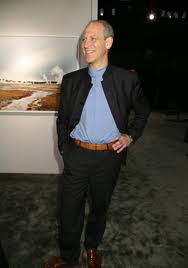Looking for something else on the web today, I came across a 6-minute interview with Museum of Modern Art director Glenn Lowry at the Stadel Museum in Frankfurt.
It was posted last spring, but what Lowry said about museums and contemporary art is evergreen, and worth both sharing and a few comments.
 First on museums: “For any museum to thrive,” he said, “it needs to grow and change and constantly rethink itself,” whether it’s a history museum or a museum of contemporary art. They should not be afraid to become a different institution, he added.
First on museums: “For any museum to thrive,” he said, “it needs to grow and change and constantly rethink itself,” whether it’s a history museum or a museum of contemporary art. They should not be afraid to become a different institution, he added.
Well, in spirit, I agree — institutions that remain embedded in amber often lose touch with reality and may sink into irrelevance. I have a little quibble with the word “grow,” however, if it is misunderstood as meaning “expand.” We’ve seen too many museums expand way beyond their capacity to sustain themselves.
On contemporary art, Lowry said:
I believe that contemporary art is central to the way any major art museum thinks about itself because ultimately the past is meaningful only to the present when we understand it. And contemporary artists are among the most important interlocutors between the past and the present anywhere in the world.
So contemporary art in a way vitalizes not only how we understand today but it’s a window into looking at the past. And I think when you can create a dialog, a conversation, an engagement between the most interesting art of today and the art of the past, that’s when you create the very rich environments that the Stadel is and will be.
On this, I am conflicted. While I would like to think what he said is true — and it certainly could be a goal, especially the last bit about those rich environments — I don’t think it is. Lots of contemporary art, even that judged to be the best by the best museums, has little, if any, relationship to “the past.” If it does, it’s not apparent, and critics that I’ve read have rarely commented on it.
So, is Lowry campaigning, so to speak, for contemporary art — making promises it doesn’t deliver on? Are critics at fault for not writing about how contemporary art is “a window into looking at the past”? Or is the content of contemporary art (in general — I realize this is a sweeping statement) itself remiss, failing to do what it is supposed to do?
Just asking.
